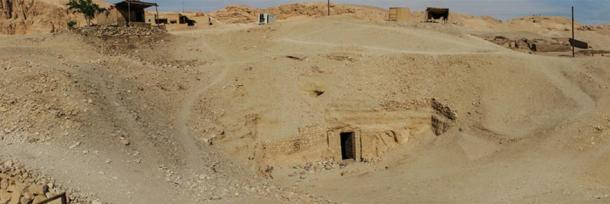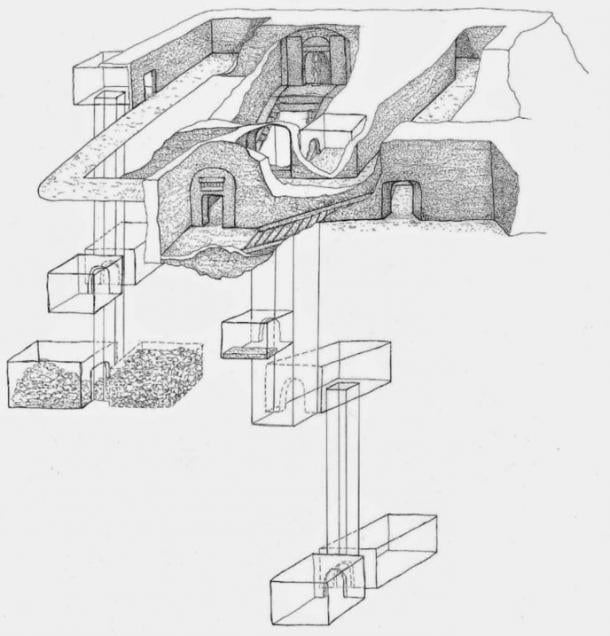Let me clarify that this tomb "represents" Osiris, and has not been verified as actual proof of his tomb. I'd expect a lot of Freemasons to be very interested in this locale in either case. The theory on all this interest in the tombs of ancient kings is not riches or knowledge, but the possibility of acquiring some DNA of these ancient rulers for cloning. We shall see...
A Spanish-Italian archaeological team, in cooperation with the Egyptian Ministry of Antiquities, has made an incredible discovery in the necropolis of Sheikh Abd el-Qurna, on the West Bank at Thebes, Egypt – an enormous ancient reproduction of the mythical Tomb of Osiris as described by Egyptian legend, complete with multiple shafts and chambers. Inside the tomb complex, researchers found a carving of Osiris and a room with a wall relief depicting a demon holding knives.

The complex consists of a large hall supported by five pillars. RTVE describes the structure as having a staircase from the north wall of the main room, leading down to the funerary complex, where there is a carving of Osiris, god of the dead, in the middle of a central vaulted temple.
To the west of the central temple is a funerary room with the reliefs of demons holding knives. The leader of the Spanish-Italian team that uncovered the tomb, Dr. María Milagros Álvarez Sosa, told EFE that the demons are there to protect the body of the deceased.
Opposite the statue of Osiris is a staircase with a 29.5 foot (9 meter) shaft leading to another chamber. Inside this chamber is a second shaft that descends 19.6 feet (6 meters) into two more rooms, which are currently full of debris.
“The symbolism of Osiris is very evident here, since all the elements recalling the mythical Osiris tomb are present,” writes Luxor Times Magazine, “a big staircase of 3.5 meter long with a 4 meter high ceiling at the bottom leading to the Netherworld and another one leading directly to the Osiris statue, which is therefore at a higher level and ideally isolated on ‘his island’; the Osiris statue itself; the empty corridor surrounding it which symbolizes the channel of water (see Osireion in Abydos); the expected burial chamber below the statue, thus identifying the deceased with Osiris.”

Read the rest of this article at - http://www.ancient-origins.net/news-history-archaeology/archeologists-discover-mythical-tomb-osiris-god-dead-egypt-002525
A Spanish-Italian archaeological team, in cooperation with the Egyptian Ministry of Antiquities, has made an incredible discovery in the necropolis of Sheikh Abd el-Qurna, on the West Bank at Thebes, Egypt – an enormous ancient reproduction of the mythical Tomb of Osiris as described by Egyptian legend, complete with multiple shafts and chambers. Inside the tomb complex, researchers found a carving of Osiris and a room with a wall relief depicting a demon holding knives.

Entrance to the funerary complex of Osiris. Photo credit: MinProject (Archaeological Mission Canaria-Toscana).
According to the Spanish news agency EFE, the tomb embodies all the features of the tomb of Osiris, as told in ancient Egyptian legends, and is a smaller version of the design of the Osireion, built under Egyptian pharaoh Seti I in the city of Abydos, Luxor. Researchers believe the tomb complex dates back to the 25th dynasty (760 - 656 BC) or 26th dynasty (672 - 525 BC), based on a comparison to similar tombs that contain Osirian elements.The complex consists of a large hall supported by five pillars. RTVE describes the structure as having a staircase from the north wall of the main room, leading down to the funerary complex, where there is a carving of Osiris, god of the dead, in the middle of a central vaulted temple.
To the west of the central temple is a funerary room with the reliefs of demons holding knives. The leader of the Spanish-Italian team that uncovered the tomb, Dr. María Milagros Álvarez Sosa, told EFE that the demons are there to protect the body of the deceased.
Opposite the statue of Osiris is a staircase with a 29.5 foot (9 meter) shaft leading to another chamber. Inside this chamber is a second shaft that descends 19.6 feet (6 meters) into two more rooms, which are currently full of debris.
“The symbolism of Osiris is very evident here, since all the elements recalling the mythical Osiris tomb are present,” writes Luxor Times Magazine, “a big staircase of 3.5 meter long with a 4 meter high ceiling at the bottom leading to the Netherworld and another one leading directly to the Osiris statue, which is therefore at a higher level and ideally isolated on ‘his island’; the Osiris statue itself; the empty corridor surrounding it which symbolizes the channel of water (see Osireion in Abydos); the expected burial chamber below the statue, thus identifying the deceased with Osiris.”

Sketch showing the outline of the tomb of Osiris. Drawing of the tomb's architecture made by Raffaella Carrera, MinProject (Archaeological Mission Canaria-Toscana).
Part of the tomb was initially discovered by archaeologist Philippe Virey in the 1880s and some attempts were made to sketch out the main structure in the 20th century. However, it was not until recently that the full extent of the structure was discovered through excavations. The funerary complex will continue to be explored and the chambers cleared of debris in the Autumn of this year.Read the rest of this article at - http://www.ancient-origins.net/news-history-archaeology/archeologists-discover-mythical-tomb-osiris-god-dead-egypt-002525